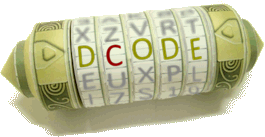Tool to convert a photon energy level into visible color, understand the energy levels of the light spectrum, interpret light in eV (Electron-Volt) and identify the corresponding colors.
Photon Energy - dCode
Tag(s) : Physics-Chemistry
dCode is free and its tools are a valuable help in games, maths, geocaching, puzzles and problems to solve every day!
A suggestion ? a feedback ? a bug ? an idea ? Write to dCode!
Photon Energy
Energy to Color Converter
Color to Energy Converter
Answers to Questions (FAQ)
What is a color's energy? (Definition)
The energy of a color corresponds to the energy of a photon associated with a light wave, measured in electronvolts (eV).
The higher the energy, the shorter the wavelength, and vice versa.
The energy of photons in the visible spectrum typically ranges from 1.6 eV (red) to 3.3 eV (violet).
How to convert an energy value (eV) to a visible color?
Converting an energy value in eV to a visible color relies on the relationship between energy, frequency, and wavelength.
Here are approximate energy ranges associated with visible colors:
— 1.6–2.1 eV (Red)
— 2.1–2.3 eV (Orange)
— 2.3–2.4 eV (Yellow)
— 2.4–2.8 eV (Green)
— 2.8–3.1 eV (Blue/Cyan)
— 3.1–3.3 eV (Violet/Blue)
These values are average estimates and may slightly vary between sources.
What is the formula to calculate the energy of a light wave?
The energy (E) of a photon is proportional to the frequency (f) of the light wave. It is given by the formula (in Joules):
$$ E = h \times f $$
where:
— $ E $ is the energy in Joules (J)
— $ h $ is Planck's constant (approximately $ 6.626 \times 10^{-34} J \cdot s $)
— $ f $ is the frequency in Hertz (Hz)
Knowing that the conversion from Joules to eV is done using the relationship $ 1 eV = 1.6 \times 10^{-19} J $
The formula (in electron-Volt) simplifies: $ E = f \times 4.1357 \times 10^{-15} eV $
Example: Red has a wavelength of 650 nm, a frequency of 460 THz, or a photon energy $ E = 460 \times 4.1357 \times 10^{-15} \approx 1.9 eV $
Why do some colors not have a well-defined energy?
Some colors do not come from a single light wave (they are not monochromatic) but from a mixture of several wavelengths.
Example: White, gray, black: depend on the overall quantity of light, not on a specific energy.
Example: Pink, magenta: come from a combination of red and blue.
Example: Brown: a dark hue derived from a low intensity of red/orange light.
These colors therefore do not have a single photon energy but are the result of complex perceptual compositions.
Source code
dCode retains ownership of the "Photon Energy" source code. Any algorithm for the "Photon Energy" algorithm, applet or snippet or script (converter, solver, encryption / decryption, encoding / decoding, ciphering / deciphering, breaker, translator), or any "Photon Energy" functions (calculate, convert, solve, decrypt / encrypt, decipher / cipher, decode / encode, translate) written in any informatic language (Python, Java, PHP, C#, Javascript, Matlab, etc.) or any database download or API access for "Photon Energy" or any other element are not public (except explicit open source licence). Same with the download for offline use on PC, mobile, tablet, iPhone or Android app.
Reminder: dCode is an educational and teaching resource, accessible online for free and for everyone.
Cite dCode
The content of the page "Photon Energy" and its results may be freely copied and reused, including for commercial purposes, provided that dCode.fr is cited as the source (Creative Commons CC-BY free distribution license).
Exporting the results is free and can be done simply by clicking on the export icons ⤓ (.csv or .txt format) or ⧉ (copy and paste).
To cite dCode.fr on another website, use the link:
In a scientific article or book, the recommended bibliographic citation is: Photon Energy on dCode.fr [online website], retrieved on 2025-12-28,
